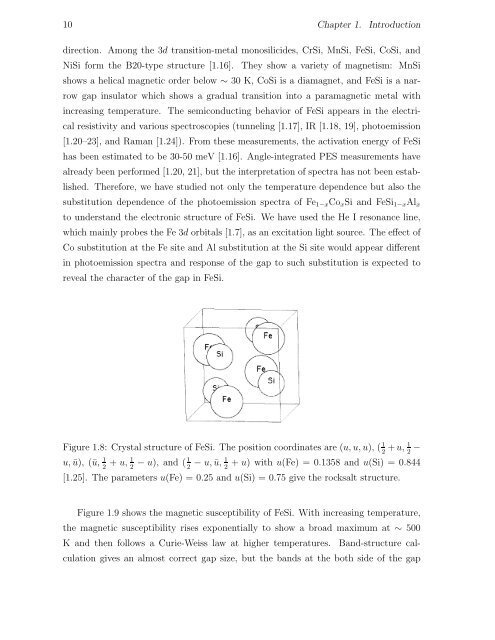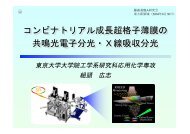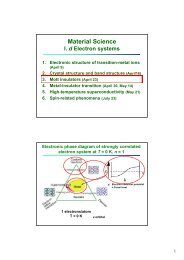Thesis High-Resolution Photoemission Study of Kondo Insulators ...
Thesis High-Resolution Photoemission Study of Kondo Insulators ...
Thesis High-Resolution Photoemission Study of Kondo Insulators ...
Create successful ePaper yourself
Turn your PDF publications into a flip-book with our unique Google optimized e-Paper software.
10 Chapter 1. Introduction<br />
direction. Among the 3d transition-metal monosilicides, CrSi, MnSi, FeSi, CoSi, and<br />
NiSi form the B20-type structure [1.16]. They show a variety <strong>of</strong> magnetism: MnSi<br />
shows a helical magnetic order below ∼ 30 K, CoSi is a diamagnet, and FeSi is a narrow<br />
gap insulator which shows a gradual transition into a paramagnetic metal with<br />
increasing temperature. The semiconducting behavior <strong>of</strong> FeSi appears in the electrical<br />
resistivity and various spectroscopies (tunneling [1.17], IR [1.18, 19], photoemission<br />
[1.20–23], and Raman [1.24]). From these measurements, the activation energy <strong>of</strong> FeSi<br />
has been estimated to be 30-50 meV [1.16]. Angle-integrated PES measurements have<br />
already been performed [1.20, 21], but the interpretation <strong>of</strong> spectra has not been established.<br />
Therefore, we have studied not only the temperature dependence but also the<br />
substitution dependence <strong>of</strong> the photoemission spectra <strong>of</strong> Fe1−xCoxSi and FeSi1−xAlx<br />
to understand the electronic structure <strong>of</strong> FeSi. We have used the He I resonance line,<br />
which mainly probes the Fe 3d orbitals [1.7], as an excitation light source. The effect <strong>of</strong><br />
Co substitution at the Fe site and Al substitution at the Si site would appear different<br />
in photoemission spectra and response <strong>of</strong> the gap to such substitution is expected to<br />
reveal the character <strong>of</strong> the gap in FeSi.<br />
Figure 1.8: Crystal structure <strong>of</strong> FeSi. The position coordinates are (u, u, u), ( 1 1 + u, 2 2 −<br />
u, ū), (ū, 1 1<br />
1<br />
1<br />
+ u, − u), and ( − u, ū, + u) with u(Fe) = 0.1358 and u(Si) = 0.844<br />
2 2 2 2<br />
[1.25]. The parameters u(Fe) = 0.25 and u(Si) = 0.75 give the rocksalt structure.<br />
Figure 1.9 shows the magnetic susceptibility <strong>of</strong> FeSi. With increasing temperature,<br />
the magnetic susceptibility rises exponentially to show a broad maximum at ∼ 500<br />
K and then follows a Curie-Weiss law at higher temperatures. Band-structure calculation<br />
gives an almost correct gap size, but the bands at the both side <strong>of</strong> the gap






